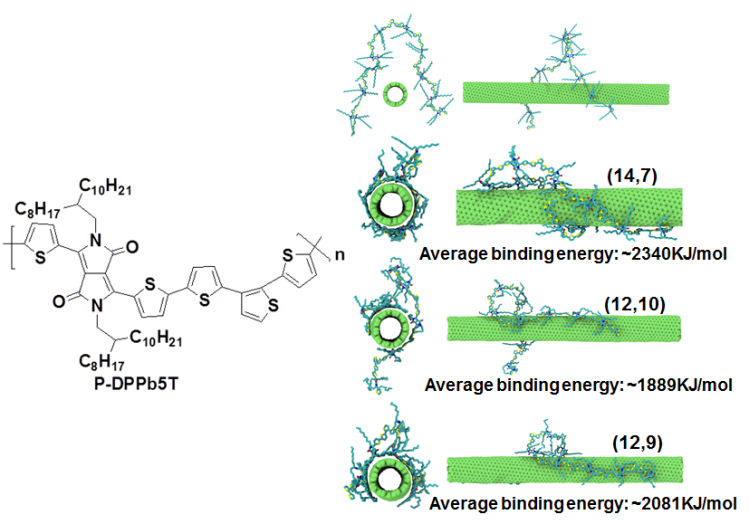Printed electronics based on carbon nanotubes is one of the main research areas at the Printable Electronics Reseach Center (PERC),Suzhou Institute of Nano-tech and Nano-bionics, Chinese Academy of Sciences. In the last 6 years, PERC researchers have developed a series of techniques to sort single-wall semiconducting carbon nanotubes (sc-SWCNTs) from arc discharged carbon nanotubes. Thin-film transistors (TFTs) have been fabricated by printing the sorted sc-SWCNTs inks and demonstrated high charge mobility and on/off ratio. Various electronic circuits have been constructed by printing and on flexible plastic substrates. These work has generated 15 scientific publications and 15 patents. Previous research activities have been mainly focused on sorting of sc-SWCNTs using commercially available polymeric materials. Recently, PERC researchers designed and synthesized a series of new conjugated compounds (P-DPPb5T, 3T, 6T, 9T and 18T) and showed that these polymers have the ability for selectively separating sc-SWCNTs from arc discharge SWCNTs. 
Figure 1 shows the sc-SWCNTs sorted by different conjugated compounds. PERC has now the capability to make 250 mL of the inks in a single process. The separation mechanism has been studied by molecule dynamics simulation, as shown in Figure 2, in collaboration with Prof. Masayoshi Tange from National Institute of Advanced Industrial Science and Technology, AIST, Japan and Dr. Jun Ye from the Institute of High Performance Computing, Singapore. TFTs made by printing DPPb5T sorted sc-SWCNTs ink exhibited excellent electrical properties with high on/off ratio of 3×107 and mobility up to 40 cm2V-1s-1, small subthrehold swing (SS) at 130~146 mV/dec, as shown in Figure 3. The relevant work has been published in Nanoscale (2016, 8, 4588-4598). 
Figure 2 The cross-sectional and the horizontal views of the wrapping configurations of P-DPPb5T on SWCNTs with different chiralities.(Nanoscale, 2016, 8, 4588-4598.) In addition, n-type and p-type top-gate TFTs have been printed on the same flexible PET substrates using the polymer-sorted sc-SWCNTs as channel materials and ALD HfO2 thin films as shared gate dielectrics (shown in Figure 3). Both show on/off ratio of ~105, mobility of ~15 cm2V-1s-1 and small hysteresis. Flexible CMOS inverter and 3-stage ring oscillator were also fabricated. The flexible CMOS inverters exhibit large noise margin at low voltage (84% of 1/2 Vdd=1.5 V), the maximum voltage gain of 30 at Vdd of 1.5 V and low power consumption (0.1μW). The printed CMOS inverters work well at 10 kHz with 2% voltage loss and delay time of ~15 μs. The 3-stage ring oscillator has the oscillation frequency of 3.3 kHz at Vddof 1 V. This work has been published on Small (2016, DOI: 10.1002/smll.201600452). 
Figure 3 The schematic illustration of fabrication and electrical properties of n-type and p-type printed TFTs, performance of printed CMOS inverters on PET substrates. (Small, 2016, DOI: 10.1002/smll.201600452). The above work was supported by National Program on key basic research project (973 Program), Strategic Priority Research Program of the Chinese Academy of Science, Natural Science Foundation of China, and Basic Research Program of Jiangsu Province. Contact information:Prof. ZHAO Jianwen Suzhou Institute of Nano-Tech and Nano-Bionics ,Chinese Academy of Science Suzhou, Jiangsu 215123, China. E-mail: jwzhao2011@sinano.ac.cn |

